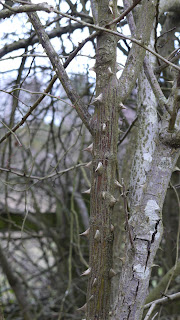Find and map all of the wild rose bushes in a one mile radius from where you live. Identify whether the rose bush is a dog rose, briar rose or Rosa Rugusa.
I went walking on the 4th as I knew there were wild roses on the other side of the hills. I never got as far as I would have liked as the weather turned stormy. I found plenty of stems that look like rose but there was no fruit and I found a bush with blackened and damaged hips.
When I got home, there on my front garden I came face to face with a miniature rose which was a gift that I planted outside and it had rose hips, could I use these?
I have had to research the difference with the varieties Sarah asked us to identify as I wasn’t sure what the differences were.
Dog Rose (Rosa Canina)
This rose has small backward facing thorns help it to climb through hedgerows. Hips are described as "flask shaped", they are oval and longer than they are wide. The hips are rich in vitamin C and can be made into a pleasant tasting syrup or honey. The hips are orange to bright red in colour. The flowers bloom in June and July are usually white or pale pink and have 5 petals. The leaves are compound with 5-7 alternate leaflets which are hairless and lighter underneath.
 |
| Wild Rose |
Briar Rose or Sweet Briar or Eglantine (Rosa Rubiginosa)
This rose also has flat backward facing thorns. Its smooth, leathery red hips are egg shaped and about 2cm long. Briar Rose’s flowers and foliage are fragrant; the blooms are up to 5cm across, a bit smaller than the dog rose’s and soft pink. The leaves are compound with 5-7 leaflets in opposite pairs. Rubiginosa means rusty in Latin and refers to the brownish-red tint often seen on the leaves and stems.
Japanese Rose (Rosa Rugosa)
The thorns of the Japanese rose are different to the dog rose and the briar rose in that they are finer and more numerous making it good for protective hedging. The hips are noticeably different as they are large, about 2-4cm across and wider than they are long. This makes the rose hips less fiddly to prepare and remove the seeds. The flowers can be pink, purple or white and 6-7cm wide. Rosa Rugosa’s leaves are dark green and wrinkled looking on top and downy underneath.
Being winter the only identification aids I could use were the stems, thorns and any remaining fruit or hips.
The first lot of stems I think are dog roses as they have the backward facing thorns but no rusty coloured tinge. The second type of bush I found had numerous fine thorns so I presume this was a Japanese rose, there were remains of hips; only one was red but it was damaged, it looked as if it had been quite wide.
 |
| Found on my rose hunt |
 |
| Remains of a rose hip on a bush with finer thorns |
 |
| Most rose hips had gone black |
I have asked my fellow apprentices about using domestic garden hips instead of wild hips and it seems that some of the nourishment may have been given up in the name of beauty and they don’t contain much flesh. Sarah of course says to try using them and see for myself. I have had a quick search on the internet and it seems that a lot of garden roses don’t have any significant hips and those that do don’t taste as good as the wild ones. Of course I decided to follow Sarah’s advice and try my garden rose hips.
 |
| Garden rose hips |
I gathered the hips this morning, some were very soft. When I cut them in half there was not much flesh, mainly seeds. I tried to deseed one and was left with hardly anything so the whole lot went into the jar.
 |
| Chopped rose hips |
Then I do confess Sarah I went a little wrong and made an elixir with honey and brandy. When I read the instructions afterwards it said to make a tincture and to put some sloes and sugar in with them. I must start reading instructions before I start! Unfortunately sloes are less common than rose hips around here at the moment but I do have some sloe gin on the go. Perhaps if I can find some more rosehips I could put them in some sloe gin?
 |
| Oops an elixir not a tincture! |
Lovely post, Jackie. Don't worry about making a tincture instead of a combined gin - I was trying to think of something you could make that you might not have tried before. We may need to wait until Autumn for the next rosehip harvest. Amzing you've got wild rugosa near you, I've only seen it in Northumberland. If you need more sloes there are still loads around the corner on the Friary field.
ReplyDeleteThank you Sarah, I didn't know the rugosa was so elusive or had such good hips before now x
ReplyDeleteThank you for posting these pictures and descriptions of the different types of wild rose .. very helpful for the novice, like me!
ReplyDeleteHi Hedgewitch, I'm glad you have found this useful, it helped me to work out the differences in the plants and now I know where to get the best hips this autumn and what to call them!
Delete